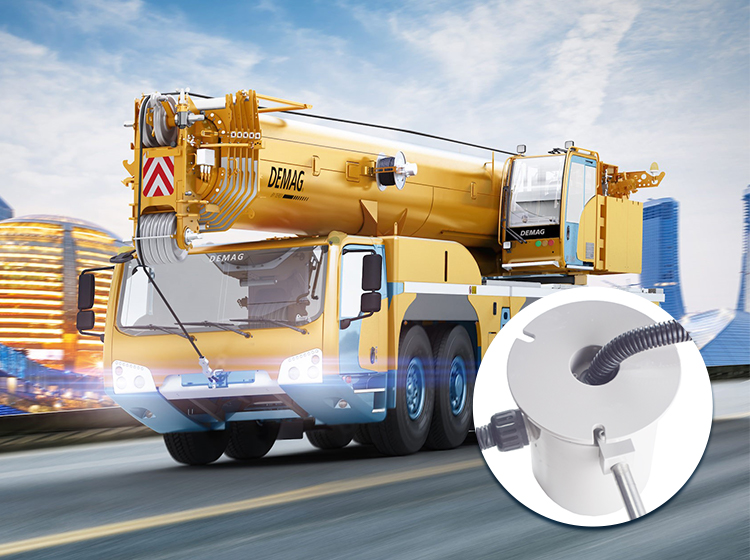Crane slip rings are critical electromechanical components that play a vital role in ensuring the efficient operation of cranes and their application in the construction industry. Their primary function is to facilitate the continuous transfer of electrical signals and data between the stationary and rotating parts of a crane, such as the crane’s main body and its rotating tower or turret. By enabling unrestricted rotation of the crane’s parts, crane slip rings help to maintain constant power and data flow, minimizing wear and tear on the crane’s components and improving the overall efficiency and reliability of crane operations.
In the construction industry, cranes are indispensable tools for moving and lifting heavy materials and payloads. Modern cranes rely heavily on crane slip rings to guarantee consistent power supply and signal transmission, especially when undertaking complex tasks that require precise control and maneuvering. This makes crane slip rings a key component in maintaining a safe and productive working environment on a construction site.
The importance of crane slip rings in the crane and construction industry cannot be overstated. They ensure efficient energy and data transfer between the different crane components, contributing to the overall performance and safety of the equipment. Furthermore, efficient crane operations help to keep construction projects on schedule and within budget, leading to better outcomes for contractors and clients. By understanding the various aspects of crane slip rings, including their design, material, installation, maintenance, and safety protocols, proper usage and preventative measures can be taken to ensure prolonged performance and extended equipment longevity.
What are Crane Slip Rings?
Crane slip rings, also known as rotary electrical interfaces, rotating electrical connectors, swivels, or electrical rotary joints, are devices used in cranes to provide a continuous electrical connection between stationary and rotating parts. In layman’s terms, imagine a crane’s body being stationary while the crane’s tower (the part that lifts and maneuvers the load) is continuously rotating. The challenge here is to ensure a steady flow of power and data from the stationary body to the moving parts, even during rotation. Crane slip rings to cater to exactly this need.
By making use of slip rings, electrical power, and signal transmission can be maintained during rotation, ensuring that the crane operates smoothly without interruption. In essence, slip rings allow cranes to perform tasks in all directions without the hindrance of twisted electrical connections, making sure the crane can function efficiently and continuously, which is vital in construction operations.
The distinct parts of crane slip rings each serve a key role in their operation. These components consist of:
- Conductive Rings: These are the metal rings that hold and conduct electrical power and signals. They are made from materials with high electrical conductivity, such as copper, silver, or even gold in some high-end models.
- Brushes: These are the elements that maintain physical contact with the conductive rings, ensuring a ceaseless electrical connection. They are often made from graphite or metal-graphite materials due to their self-lubricating and conductive properties.
- Enclosure: This component, made from robust and reliable materials like stainless steel or aluminum, protects the internal parts of the slip ring from environmental hazards while maintaining the structural rigidity of the entire unit.
- Bearings: These parts ensure the smooth rotation of the slip ring and are often sealed to prevent wear and tear from external factors.
- Lead Wires: These are the wires that carry the electrical power and signals from the slip ring to the crane’s rotating parts and vice versa.
By understanding the distinctive parts and their specific roles, users can better appreciate the ingenuity behind the design of crane slip rings, their contribution to the overall machinery’s functionality, and the necessity of proper maintenance for sustained optimal performance.
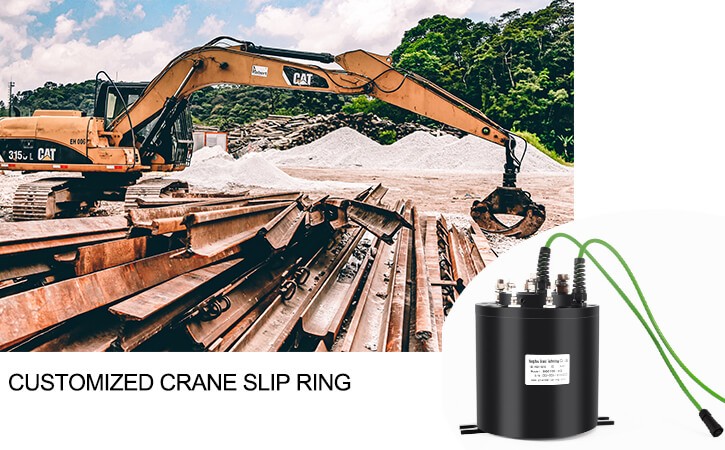
Types of Crane Slip Rings
Crane slip rings come in a variety of types, each designed to serve different applications or solve unique engineering problems within crane operations. The characteristics, construction, and performance of these types reflect the various requirements and constraints in which cranes are used, whether it’s the space available for installation, the nature of the signal to be transmitted, or certain environmental conditions.
Pancake Slip Rings
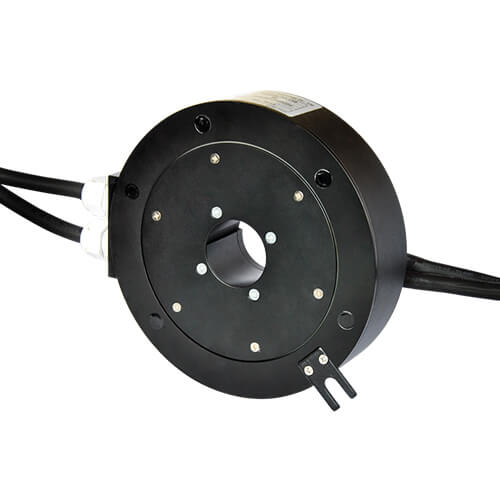
Pancake slip rings are characterized by their slim, disc-like structure. This design is advantageous where the length along the rotation axis has to be minimized due to limited vertical space. However, the main challenge in pancake slip rings usually lies in maintaining reliable contact since centrifugal forces depend on the distance from the rotation center. Despite this, they’re highly suited to applications where space is limited but the diameter isn’t a concern.
Through-hole Slip Rings
As the name suggests, through-hole slip rings come with a central hole to accommodate a shaft or another component around which the slip ring rotates. This central hole provides excellent design flexibility, enabling more compact installations in applications where the slip ring can be integrated around an existing structure. This type of slip ring is ideal in crane applications where the already existing shafts or assemblies are to be made rotatable.
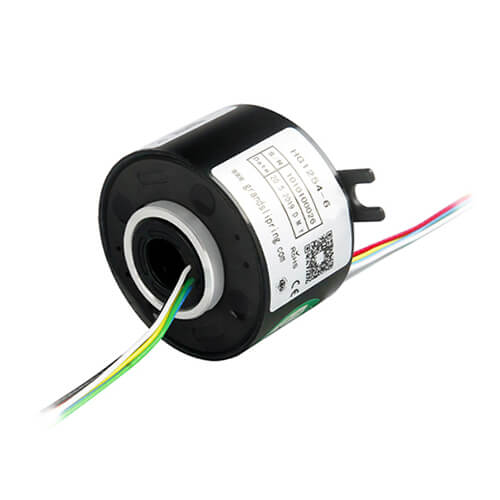
Wireless Slip Rings
Also known as rotary transformers or induction slip rings, these slip rings transmit electrical signals wirelessly through electromagnetic coupling. By doing away with the need for physical contact, they eliminate problems related to mechanical wear and tear, offering a contact-free, maintenance-free solution. However, these devices may not be as efficient in power transmission compared to their contact counterparts and are commonly employed in environments where physical contact isn’t viable or desired for reasons such as strict hygiene standards or high-speed rotation.
Fiber Optic Rotary Joints (FORJs)
These are specialized slip rings designed for transmitting optical signals. FORJs are perfect for data-intensive applications, including those requiring high-speed signal transmission over long distances or where electromagnetic interference is a concern. However, their complexity and cost make them less suitable for simple power transmission tasks.
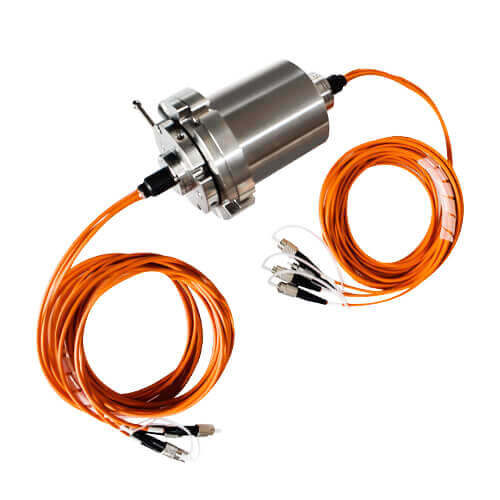
Each type of crane slip ring presents its own benefits and potential constraints. The choice of which to utilize relies heavily on a clear understanding of the crane’s requirements, operating environment, and the specific challenges posed by each application.
Design and Construction of Crane Slip Rings
To create reliable and efficient crane slip rings, certain design principles must be adhered to, to ensure the overall effectiveness of the slip ring system. A well-designed and constructed slip ring will not only fulfill its purpose but also minimize potential issues and prolong its lifetime. These design principles are crucial in achieving the desired performance and durability, ultimately contributing to the effective operation of the crane itself.
Design Principles
- Compact Design: A well-designed slip ring should have a compact structure that is easy to install in cranes while minimizing space consumption. This often involves using robust materials and efficient calibration methods, which contribute to the slip ring’s structural integrity and performance.
- High Current and Voltage Capacity: To support the different loads and fluctuations in crane operations, the slip ring needs to be able to carry high currents and voltages without failure or overheating. This requires the use of proper design and materials to withstand extreme conditions while avoiding unnecessary energy loss.
- Integration and Compatibility: The design and construction of crane slip rings should also consider seamless integration with the crane’s existing components. This means ensuring easy installation, efficient energy transfer, and compatibility with the crane’s control systems.
- Reliability and Durability: An efficient crane slip ring must be robust and long-lasting. This entails using wear-resistant materials and incorporating advanced manufacturing techniques to create a product that can withstand extended usage and harsh environments.
Material Selection and Its Impact on Performance and Durability
The choice of materials plays a pivotal role in the overall performance and longevity of crane slip rings. Different materials have varying properties, which can significantly affect the electrical conductivity, wear resistance, and service life of the end product.
- Contact Brushes: Materials used for contact brushes need to provide excellent conductivity as well as wear resistance. Common materials used include graphite, metal-graphite compounds, gold, and silver. While gold offers superior conductivity and corrosion resistance, its high price often limits its use in critical applications. Graphite and metal-graphite brushes offer a good balance between conductivity and durability while remaining more budget-friendly.
- Conductive Rings: To achieve good electrical contacts and longevity, the conductive rings should be made from materials with excellent conductive properties and low susceptibility to wear. Stainless steel, copper, plated gold, and brass are frequent choices for these components.
- Enclosure: The slip ring enclosure should be built from robust materials that can protect the internal components from environmental factors, corrosion, and physical impacts. Stainless steel, aluminum, and engineering plastics are common options for these protective casings.
Proper selection of materials that balance performance, durability, and cost is crucial to the success of a crane slip ring. By adhering to the guiding design principles and understanding the effect of material choices on slip ring functionality, manufacturers can build products that optimize performance, durability, and reliability, all the while ensuring the safety and efficiency of crane operations.
Crane Slip Ring Installation
The successful operation of a crane slip ring largely depends on the quality of its installation. An incorrectly installed slip ring can lead to numerous problems, such as loss of power transmission, premature failure of the slip ring, and even safety risks. Therefore, correct installation is paramount to maximize the performance and lifespan of the slip ring. Here is a step-by-step guide on how to properly install a crane slip ring:
- Choose the Correct Location: Select an appropriate location for the slip ring. This location should be dry, cool, and free from excessive vibration. Placement near high heat or vibration sources should be avoided, as these can affect the performance and longevity of the slip ring.
- Prepare the Slip Ring: Unpack the slip ring, being careful not to damage any parts during the process. Check the slip ring for any visible defects or damage. Refer to the slip ring manual to familiarize yourself with the parts and installation instructions.
- Mount the Slip Ring: Once the ideal location has been decided, mount the slip ring using the provided mounting hardware such as flanges or brackets. Ensure to firmly fix the slip ring using the appropriate tools to avoid any movement during operation.
- Connect the Wiring: Carefully connect the wires to the respective contact points. Ensure that your wiring matches the wiring diagram provided in the manual to prevent any problems with power and signal transmission.
- Check the Installation: With the slip ring securely mounted and wired, conduct a final check to ensure that everything is correctly installed. Make sure there are no loose wires, the slip ring is secure, and the seals are correctly positioned to prevent contaminant ingress.
Although installing a crane slip ring is generally straightforward, some potential pitfalls should be avoided:
- Incorrect Wiring: One of the most common mistakes during installation is incorrect wiring. This can result in power loss, signal interference, or even damage to the slip ring. Always refer to the wiring diagram in the installation manual to provide guidance.
- Poor Mounting: If the slip ring is not mounted correctly, it can lead to vibration during operation, which can cause premature wear and potential failure of the slip ring. Always ensure the slip ring is securely mounted before use.
- Ignoring the Operating Environment: Regardless of how well a slip ring is designed or installed, ignoring the operating environment can greatly impact its performance and lifespan. Ensure that conditions such as temperature, humidity, and potential exposure to dust and debris are taken into account when installing the slip ring.
Proper installation of crane slip rings is a crucial phase that determines the overall operational efficiency, lifespan, and safety of crane operations. Through proper preparation and execution, potential operational issues can be circumvented leading to prolonged performance and equipment longevity.
Crane Slip Rings Routine Maintenance and Inspection
In any crane operation, the slip ring is a critical component that ensures smooth transmission of power and signals. Ensuring the proper functioning and maximizing the lifespan of slip rings requires regular maintenance and inspections. With the right attention, potential issues can be mitigated, ultimately prolonging the operational life and efficiency of the crane.
Importance of Regular Maintenance and Inspection
- Identifying Wear and Tear: Regular inspections help to identify wear and tear in the slip ring components, such as worn brushes or collected debris. Identifying these issues early on can prevent unexpected system failures and component damage.
- Preventing Downtime: Unplanned downtime can be costly in terms of lost productivity and revenue. Through regular maintenance, potential issues can be addressed before they escalate, helping to minimize downtime and achieve more predictable crane operations.
- Enhancing Safety: Cranes with slip rings are often employed in safety-critical environments. Regular inspection and maintenance of the slip rings can help identify potential safety hazards and address them before they pose a risk to people and equipment.
- Extending Equipment Lifespan: Through routine maintenance and inspection, the longevity of the slip ring and related components can be maximized, ensuring a high return on investment and reducing the frequency of replacements.
Step by Step-by-step guide on How to Perform Regular Inspections and Maintenance Operations
- Safety First: Before beginning any maintenance or inspection, always ensure that the crane is powered down and locked out to prevent any accidental activation.
- Visual Inspection: Start with a visual inspection of the slip ring components. Look for signs of wear, damage, or corrosion. Check for loose connections, worn brushes, worn contacts, or any debris collected on the surface of the conductive rings.
- Clean the Slip Ring: Using a lint-free cloth or a soft brush, gently remove any dust or debris from the slip ring’s surface. In some cases, a non-abrasive cleaner might be required to remove stubborn debris or accumulated dirt.
- Replace Worn Components: If any worn brushes or contacts are found during the inspection, replace them as per the manufacturer’s guidelines. This will help maintain the slip ring’s performance and avoid any failures due to worn components.
- Check Seals and Enclosures: Inspect seals and enclosures for any signs of wear, cracks, or deformation. Replace them if necessary to ensure proper protection against environmental contaminants.
- Test the System: Once the inspection and maintenance tasks are completed, power up the crane and run it through its normal operating procedures. Observe the slip ring’s performance, and if any issues persist, consult with the manufacturer or a qualified technician for assistance.
Regular maintenance and inspection of crane slip rings are critical to maintaining top performance, minimizing downtime, and ensuring the safety of those working around cranes. By adhering to a consistent and thorough maintenance regimen, operators can maximize the lifespan and efficiency of their crane slip ring system.
Crane Slip Rings Troubleshooting Common Problems
Crane slip rings, like any mechanical component, may face various challenges during their operation life. These issues can affect operational efficiency, and reliability, and put a substantial burden on the overall system. Being able to identify common problems and effectively troubleshoot these issues can significantly reduce downtime and maintain the smooth operation of the crane.
Common Problems Associated with Crane Slip Rings
- Wear and Tear: After prolonged use, slip ring components may show signs of wear and tear. This can result in loss of signal transmission or reduced operational efficiency. Over time, the brushes and the contact surface of the slip ring can become worn, leading to inefficient transmission of power and signals.
- Contamination: Accumulation of dust, grime, or moisture is a common problem. Contaminants can affect the electrical contact, inhibit rotation, or lead to corrosion that causes permanent damage to the slip ring components.
- Intermittent Signal: Intermittent power or signal loss is often a sign of a problem with the slip ring. This could be due to a poor electrical connection between the brushes and the contact surface, possible mechanical misalignment, worn-out brushes, or a damaged conductive ring.
- Excessive Noise or Vibration: In some cases, the slip ring may produce excessive noise or vibration. This can be a result of incorrectly mounted slip rings, unbalanced loading on the rotary joint, or worn-out bearings.
Tips and Instructions to Troubleshoot These Common Issues
- Wear and Tear: Regular inspection for signs of wear and tear on the brushes and contact surface is necessary. In case these components are worn out beyond their operational limit, then replacing the worn parts with new ones would be the best solution.
- Contamination: Regular cleaning of the slip ring unit can prevent the accumulation of contaminants. In case of severe contamination, using a mild, non-abrasive cleaner can help. Extreme cases of rust or corrosion might necessitate part replacement.
- Intermittent Signal: Check the contact between the brushes and the conductive rings. Ensure that there are no loose connections. The brush pressure might also need adjustment. If the problem persists, consider consulting with a professional.
- Excessive Noise or Vibration: Ensure that the slip ring is correctly mounted and the mounting bolts are tightened. Check for misalignment and correct as necessary. In the case of worn-out bearings, the bearings should be replaced.
Mastering the identification and troubleshooting of these common issues will save costly repairs, ensure more consistent operation, extend the service life of the equipment, and improve overall productivity. As always, if the issue persists after troubleshooting, it is advisable to seek professional assistance.
Safety Tips for Using Crane Slip Rings
Crane slip rings form an essential part of the crane mechanism, ensuring efficient power and signal transmission between the movable and stationary parts of the crane. However, due to their nature of operation, they should be handled with care, observing all the necessary safety protocols during installation, inspection, operation, and maintenance.
Safety Measures to Take while Installing, Inspecting, and Operating Crane Slip Rings
- Turn Off and Lock Out Equipment: Before starting any work related to the slip ring, it’s imperative to turn off the power to the crane and apply lockout/tagout procedures to prevent any accidental startups, which could result in injuries.
- Use Proper Personal Protective Equipment (PPE): Wear appropriate PPE, including gloves, safety glasses, and in some cases, face shields or dust masks, when installing or servicing the slip ring.
- Conduct Regular Inspections: Regular safety inspections can identify potential issues such as wear and tear or loose connections, which can result in accidents or equipment failures.
- Stay Clear of Moving Parts: When the crane is operational, stay clear of all moving parts, including the slip ring. This will help avoid accidents resulting from contact with these parts.
- Follow Manufacturer’s Guidelines: Always abide by the manufacturer’s instructions during installation, inspection, and operation. The guidelines are designed to ensure the safe and effective use of the slip ring.
Explanation of How Slip Rings Contribute to Overall Crane Safety
Crane slip rings play an essential role in maintaining the overall safety of crane operations. They enable the smooth transmission of power and signals from the stationary part of the crane to the rotating part, allowing for accurate control and smooth operation of the crane.
- Stable Power Transmission: By seamlessly transmitting power and signals, slip rings help maintain stable and efficient crane operations, reducing malfunctions that can lead to accidents.
- Reduction of Tangled Cables: Slip rings eliminate the need for hanging cables, reducing the risks related to entanglement or snagging of cables, and improving the site safety.
- Enables Continuous Rotation: Slip rings allow for 360-degree continuous rotation of the crane without the risk of cable twists, providing safer and more efficient operations.
- Reliable Signal Transmission: Slip rings contribute to the safety of the crane by ensuring reliable signal transmission for control, which directly impacts the accurate and safe operations of the crane.
Handling crane slip rings safely and understanding their role in overall crane safety is an essential aspect of maintaining a safe and productive work environment. Therefore, users are always advised to adhere to all safety practices and guidelines established by the manufacturer.
Crane Slip Rings: Compliance with Local and International Standards
Crane slip rings, as critical components in crane operations, must adhere to various local and international standards. These standards – set forth by entities such as the International Organization for Standardization (ISO), Occupational Safety and Health Administration (OSHA), and other relevant bodies – are designed to ensure the safety, reliability, and longevity of such components.
Key Local and International Standards for Crane Slip Rings
- ISO Standards: The International Organization for Standardization provides guidelines for the design, manufacture, and testing of rotating electrical connectors, including crane slip rings. ISO 9001 emphasizes quality management systems and processes, while ISO 14001 focuses on environmental management systems.
- OSHA Standards: In the United States, the Occupational Safety and Health Administration sets forth guidelines for safe workplace practices. While OSHA doesn’t have specific standards for crane slip rings, its specifications for crane safety mechanisms and procedures are comprehensive.
- European Standards: In Europe, EN 13000 is the specific standard that stipulates safety requirements for cranes. These standards encompass a wide range of aspects, including electrical and mechanical components like slip rings.
Importance of Compliance with These Standards for Safety and Product Longevity
Compliance with local and international standards ensures that the crane slip rings and the cranes themselves adhere to the recommended safety and technical specifications. This has several benefits:
- Safety Compliance: Adhering to these standards helps ensure that cranes are safe for use and that mishaps are minimized. It makes certain that the operations involving cranes equipped with slip rings meet the acceptable safety best practices, thus avoiding potential accidents and promoting a safer operational environment.
- Product Quality: By complying with established standards, manufacturers can ensure the quality, durability, and reliability of their crane slip rings. This results in fewer malfunctions and a longer product lifespan.
- Regulatory Compliance: Compliance with standards also ensures that the cranes and their components meet the regulatory requirements specific to each region or country. This helps operators avoid legal complications and penalties tied to non-compliance.
- User Confidence: Products that adhere to recognized standards generate more confidence among end-users. Following standardized manufacturing and quality control processes ensures users that they’re using a product that meets or exceeds industry standards.
Thus, understanding and complying with local and international standards is crucial for all manufacturers and operators of crane slip rings. It not only enhances safety and product longevity but also contributes positively towards brand reputation and customer trust.
Conclusion
Understanding the various aspects of crane slip rings, from design and function to installation and maintenance, is crucial for their proper use. By adhering to essential safety guidelines and regulatory standards, the lifespan and performance of crane slip rings can be maximized, ensuring seamless operation in the construction industry.
FAQs about Crane Slip Rings
Q1: What is a crane slip ring?
A: A crane slip ring is an electromechanical device that enables uninterrupted power, data, and signal transmission between the stationary and rotating parts of the crane. It allows for continuous 360-degree rotation, avoiding tangling and twisting of cables, and ensures smooth and efficient crane operations.
Q2: What are the key components of a crane slip ring?
A: The main components of a crane slip ring include conductive rings, brushes, a rotor, and a stator. Conductive rings are mounted on the rotor, while brushes are positioned on the stator. These brushes maintain a sliding electrical contact with the conductive rings to ensure seamless transfer of power, signals, or data.
Q3: How often should crane slip rings be inspected and maintained?
A: The frequency of inspection and maintenance largely depends on usage and environmental factors. It’s generally advised to perform periodic visual inspections throughout the operation life. The inspection should focus on signs of wear and tear, proper alignment, and any accumulation of dirt or debris. Conduct a more thorough inspection every six months to one year, or as recommended by the manufacturer.
Q4: Can crane slip rings be repaired or do they need to be replaced when they fail?
A: Some slip ring issues can be repaired, such as replacing worn-out brushes, cleaning contact surfaces, adjusting brush pressure, or fixing mechanical misalignment. However, in cases where damage has occurred to the conductive rings or the slip ring assembly as a whole, it may be more cost-effective to replace the entire slip ring unit.
Q5: How does temperature affect the performance of crane slip rings?
A: Extreme temperatures can have an impact on the performance of crane slip rings. High temperatures can cause the expansion of metal components, affecting proper contact between the brushes and conductive rings. Extremely low temperatures could cause the lubricant to thicken, impairing rotation. Ensure that the slip ring is suitable for the operational environment, including its temperature range; follow the manufacturer’s guidelines for proper operation.
Q6: How do crane slip rings contribute to overall crane safety?
A: Crane slip rings maintain efficient power and signal transmission, ensuring accurate control and smooth operations. They eliminate the need for hanging or draped cables, reducing the risk of entanglements or snags, and they allow for 360-degree continuous rotation, ensuring safer and more efficient crane use.
If you encounter any specific problems or need further guidance, consult the crane slip ring manufacturer or a qualified professional.
See What We Can Do

